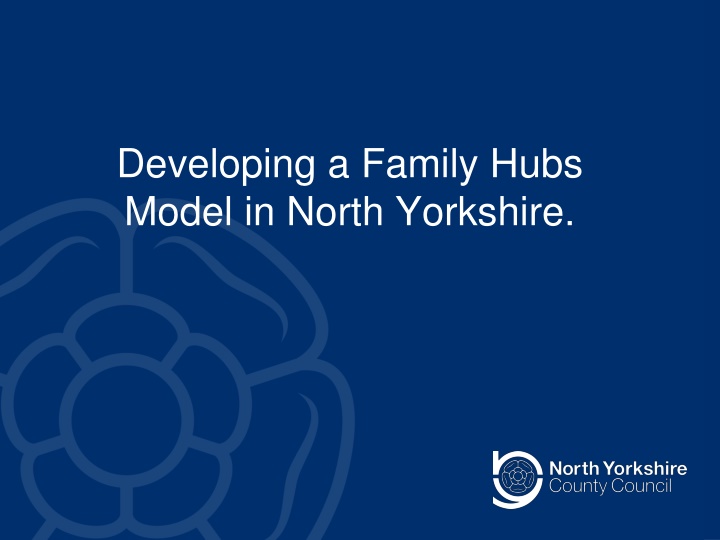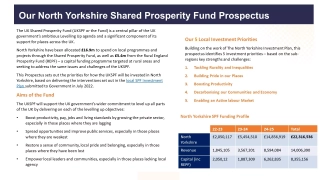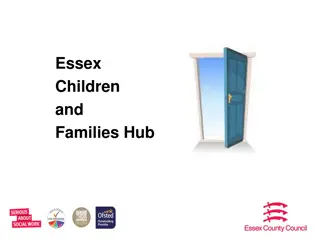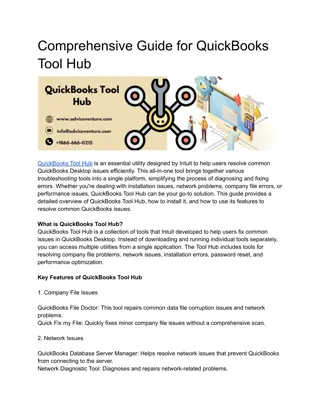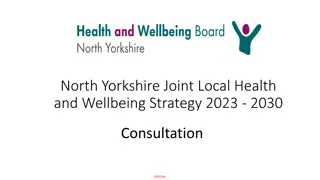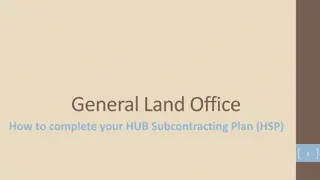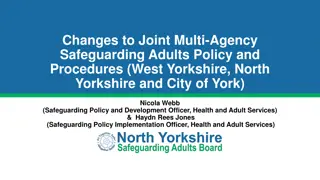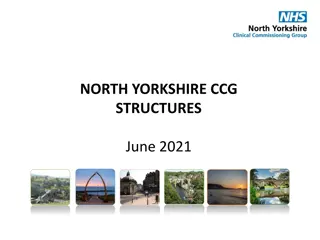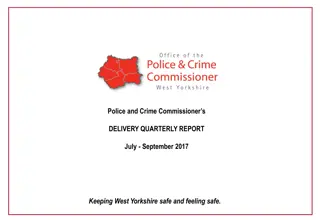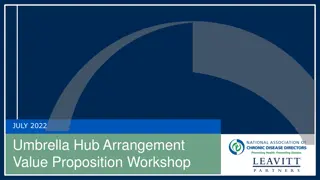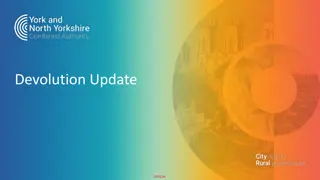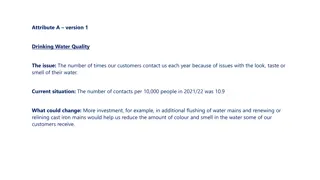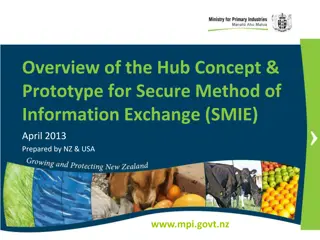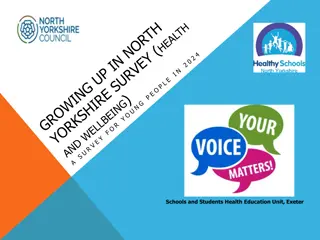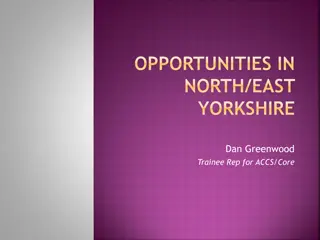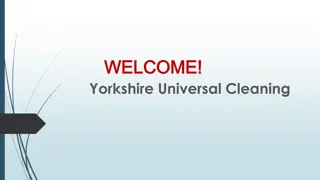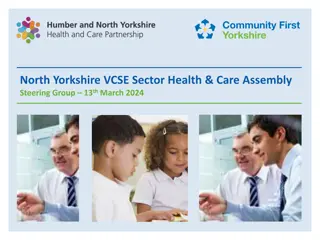Family Hub Network Model in North Yorkshire
Developing a Family Hubs Model in North Yorkshire aims to provide integrated early help and support for families with children aged 0-19 through a network of accessible locations offering a range of services. Family Hubs serve as a central access point for families, connecting them to needed support services such as health, education, and community resources. The model emphasizes three key principles: Access, Child & Family Relationships, and Connections, promoting a family-friendly culture that is inclusive and supportive across all age groups.
Uploaded on Oct 07, 2024 | 1 Views
Download Presentation

Please find below an Image/Link to download the presentation.
The content on the website is provided AS IS for your information and personal use only. It may not be sold, licensed, or shared on other websites without obtaining consent from the author.If you encounter any issues during the download, it is possible that the publisher has removed the file from their server.
You are allowed to download the files provided on this website for personal or commercial use, subject to the condition that they are used lawfully. All files are the property of their respective owners.
The content on the website is provided AS IS for your information and personal use only. It may not be sold, licensed, or shared on other websites without obtaining consent from the author.
E N D
Presentation Transcript
Developing a Family Hubs Model in North Yorkshire.
Will Quince - Minister for Children and Families At their simplest, a family hub is where families with children of all ages know they can get help and support. They may go to a building, or they may access that help online or maybe a mix of the two. The exact service offer will vary from place to place, as it should, reflecting the needs of the local population, but will have a great Start for Life offer for parents, carers and babies at its core. And it is not just help from the local authority that should be available through a hub. The hub should connect families with services and support from others, in a joined up way whether that is links to more targeted health services, links with schools and education settings, support from charity or community groups, or even other parents. Josh MacAlister (Led independent review of Social Care) Community is the first line of defence but we do not utilise its full potential to help families. OFFICIAL - SENSITIVE
Family Hub Network Model Family Hubs ensure families with children and young people aged 0-19 can access integrated early help to overcome difficulties and build stronger relationships. Family Hubs are networks of people and places working together to reach and support families who need help. They come in all shapes and sizes: libraries, faith buildings, schools, early years settings, community halls. Family Hubs enable every area to make the best use of their buildings and sites that are available. It s important that families know where to go and get help, and that staff and volunteers are trained to respond sensitively and effectively to families enquiries and have extensive knowledge of the other people and places within the network. A Family Hub can signposts families to services co-located within the same building but is equally integrated with services provided at other delivery sites ( spokes of the hub). OFFICIAL - SENSITIVE
Three key principles underpinning Family Hub Networks form the Model Framework for delivery. Access Child & Family Relationships Connections OFFICIAL - SENSITIVE
Access Single Access Point Single front door to services Physical places where a family can access help, with a clear Virtual Offer Clear branding - Comms and information about the hub and the offer to families that includes a minimum of the Start for Life Offer Goes beyond 0-5 children's centres: support for families with children of all ages including ante-natal up to age 19 Outreach to proactively engage harder to reach families Family Friendly culture that is open, welcoming and works with the whole family Accessibility and equality across protected characteristics OFFICIAL - SENSITIVE
Connections For families to know how and where to get help Co-location of services, professionals with a strong emphasis on third sector and community delivery Community ownership and Co-production - Voice of child and family and community Locality led joint governance, commissioning and shared outcomes between partners and services Evaluation and measurement of impact Data sharing between partners, case management for the whole family and an Early Help assessment of the whole families needs A focus on universal and early help services but with clear referral and escalation routes OFFICIAL - SENSITIVE
Relationships Relationship practice model that prioritises building on family strengths & whole family Greater integration between people - professionals and leaders that work with families Training and development for a multi agency workforce to work in a whole family approach building strong relationships with families and identification of early need. Raising awareness so that local communities are our eyes and ears as they play such a vital role as a support network for our families. OFFICIAL - SENSITIVE
Family Hub Network Model Building on whats already in place Early Development work in Early Help - Clear Vision & Aim Delivery of 0-19 offer Small Grants fund Grow & Learn project Work with libraries, Registrars, EY settings & Health Social prescribing Autism project Streets Ahead Part of Hidden Harm Agenda OFFICIAL - SENSITIVE
How do you see your area of the service within the Family Hub Network model? How will you ensure that the children, young people and their families you work with are engaged in the co-production of the Family Hub Network model? How do we use opportunities arising from the Healthy Child Partnership agreement and the Local Government Review to work with district councils, primary care, education and the voluntary and community sectors? What model for Family Hub Networks would work best in North Yorkshire? OFFICIAL - SENSITIVE
Key documents identified within the framework Family_Hub_Model_Framework.pdf Policy paper overview: The best start for life: a vision for the 1,001 critical days - GOV.UK (www.gov.uk) Guidance overview: Troubled Families: early help system guide - GOV.UK (www.gov.uk) Reducing Parental Conflict: tools for commissioners, managers and leaders - GOV.UK (www.gov.uk) Early Intervention Foundation (EIF) Commissioner Guide www.annafreud.org/mental-health-professionals/national-centre- for-family-hubs/ OFFICIAL - SENSITIVE
